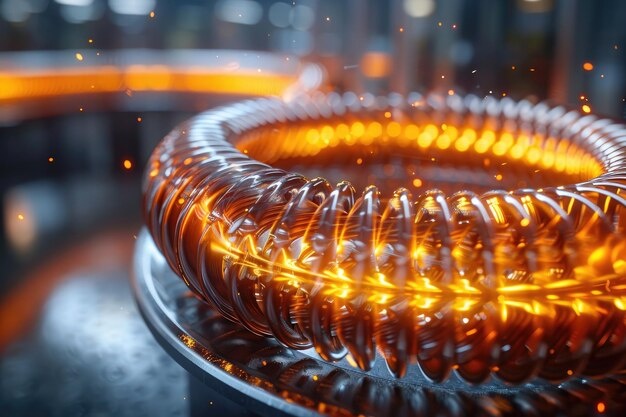Innovations in Steel Coil Slitting: The Future of Metal Processing

In the rapidly evolving landscape of metal processing, steel coil slitting has emerged as a vital technique, serving as the backbone for numerous industries. This article delves into the innovations transforming steel coil slitting, highlighting the advancements that promise to redefine productivity, efficiency, and safety in metal processing
Understanding Steel Coil Slitting
Steel coil slitting is a specialized method of cutting wide coils of steel into narrower strips. This process not only enhances the usability of the material but also minimizes waste, making it a crucial component in various manufacturing sectors.
The Process Explained
The slitting process begins with a master coil that is unwound and fed into a slitting line. Here, the coil is cut into specified widths using sharp blades. The process involves several steps:
- Uncoiling: The master coil is mounted on an uncoiler that unwinds it smoothly.
- Slitting: High-precision rotary knives slice the coil into desired widths.
- Re-coiling: The slit coils are then re-coiled for ease of handling and transportation.
Key Benefits of Steel Coil Slitting
- Precision: Advanced technologies ensure that each strip is cut to exact specifications, meeting the stringent requirements of various applications.
- Efficiency: By reducing material waste, manufacturers can optimize their production processes and lower costs.
- Versatility: Steel coil slitting is applicable to a range of materials, including stainless steel, carbon steel, and aluminum, making it suitable for multiple industries.
Innovations Driving Change
The steel coil slitting industry is experiencing a technological revolution. Innovations in machinery and processes are enhancing efficiency and precision while minimizing environmental impact.
Automation and Robotics
The integration of automation in steel coil slitting lines is a game-changer. Automated systems streamline operations, reducing the need for manual labor and increasing safety.
- Automated Loading and Unloading: Modern machines are equipped with automated systems that handle the loading and unloading of coils, minimizing human intervention.
- Robotic Arms: These arms can perform tasks such as positioning and guiding materials, enhancing accuracy and speed.
Advanced Cutting Technologies
Innovations in cutting technologies are significantly improving the quality of slit coils.
- Laser Cutting: Utilizing high-powered lasers, manufacturers can achieve exceptional precision and edge quality, reducing burrs and maximizing yield.
- High-Speed Rotary Shears: These machines employ rotating blades to shear steel at remarkable speeds, significantly boosting output while maintaining clean cuts.
Sustainability in Steel Processing
As industries become more environmentally conscious, the steel coil slitting sector is adapting to meet these sustainability goals.
Energy-Efficient Machinery
Manufacturers are increasingly focusing on energy-efficient machines that consume less power. Key features include:
- Variable Speed Drives: These allow for optimized energy consumption based on operational needs.
- Regenerative Braking Systems: These systems capture energy during braking, reducing overall energy usage.
Waste Reduction Strategies
Innovations in slitting technology also aim to minimize waste. By optimizing cutting patterns and utilizing advanced software, manufacturers can significantly reduce scrap material.
The Role of Data Analytics
The use of data analytics in steel coil slitting is transforming how manufacturers monitor and optimize their processes.
Real-Time Monitoring
Data-driven insights allow for real-time monitoring of machine performance, enabling operators to make informed decisions.
- Performance Metrics: By tracking parameters such as speed, tension, and temperature, operators can identify inefficiencies and address them promptly.
- Predictive Maintenance: Utilizing data analytics, manufacturers can anticipate machine failures before they occur, reducing downtime and maintenance costs.
Enhanced Quality Control
Data analytics also plays a crucial role in quality control. By analyzing production data, manufacturers can ensure that each coil meets the required specifications.
Future Trends in Steel Coil Slitting
As technology continues to advance, several trends are shaping the future of steel coil slitting.
Increased Customization
The demand for customized solutions is on the rise, driven by the need for tailored products in various industries. Manufacturers are investing in flexible slitting lines that can accommodate different coil sizes and specifications.
Smart Manufacturing
The concept of smart manufacturing is gaining traction, integrating IoT (Internet of Things) technologies into steel processing. This trend enables manufacturers to connect machines and systems, facilitating seamless communication and data exchange.
- Connected Systems: By linking machines to a central system, manufacturers can monitor operations in real time and optimize workflows.
- Remote Access: Operators can access machine data remotely, allowing for quick adjustments and troubleshooting.
Applications Across Industries
Steel coil slitting is utilized in a myriad of industries, each with specific requirements and applications.
Automotive Industry
In the automotive sector, precision is paramount. Steel coil slitting is used to produce components such as:
- Body Panels: Slit coils are transformed into body panels that meet stringent safety and quality standards.
- Structural Parts: The ability to customize dimensions ensures that structural components fit perfectly in various vehicle designs.
Construction Sector
The construction industry relies heavily on steel for structural integrity. Slit coils are employed in applications such as:
- Reinforcement Bars: Steel coils are cut into bars used for reinforcing concrete structures.
- Roofing Materials: Slit coils can be processed into sheets for roofing applications, ensuring durability and weather resistance.
Electronics Manufacturing
In the electronics sector, precision cutting is crucial for producing components like:
- Connectors: Slit coils are used to manufacture connectors that require exact dimensions for optimal performance.
- Brackets and Enclosures: The ability to cut materials to specific sizes is essential for creating various electronic enclosures.
Challenges in Steel Coil Slitting
Despite the advancements in technology, the steel coil slitting industry faces several challenges that need to be addressed.
Material Variability
The variability in raw materials can impact the slitting process. Different steel grades may require specific cutting techniques and settings.
- Quality Assurance: Ensuring consistent quality across various steel grades is vital for maintaining product standards.
- Adaptability: Manufacturers must invest in adaptable machinery that can handle different materials effectively.
Market Fluctuations
The steel industry is often subject to market fluctuations, affecting demand and pricing. Manufacturers must remain agile to navigate these changes.
- Cost Management: Strategies for managing costs while maintaining quality are essential for staying competitive.
- Diversification: Exploring new markets and applications can help mitigate risks associated with market volatility.
Training and Skill Development
As technology evolves, the need for skilled operators becomes increasingly important.
Comprehensive Training Programs
Investing in training programs ensures that operators are well-versed in the latest technologies and safety protocols.
- Hands-On Training: Practical training sessions enable operators to familiarize themselves with machinery and processes.
- Continuous Learning: Ongoing education keeps operators updated on technological advancements and best practices.
Safety Protocols
Safety remains a top priority in steel coil slitting operations. Implementing comprehensive safety protocols is essential for protecting workers.
- Personal Protective Equipment (PPE): Operators should be equipped with appropriate PPE to minimize risks.
- Regular Safety Audits: Conducting safety audits helps identify potential hazards and implement corrective measures.
The Impact of Globalization
Globalization has significantly influenced the steel coil slitting industry, creating both opportunities and challenges.
Expanding Markets
With the rise of global trade, manufacturers can access new markets, increasing demand for steel products.
- Export Opportunities: Companies can expand their reach by exporting slit coils to international markets.
- Competitive Advantage: Leveraging global supply chains can enhance competitiveness and reduce costs.
Increased Competition
While globalization presents opportunities, it also intensifies competition. Manufacturers must innovate to differentiate themselves.
- Quality Differentiation: Focusing on quality and precision can set manufacturers apart in a crowded market.
- Technological Advancements: Investing in cutting-edge technology can provide a competitive edge.
Conclusion
The future of steel coil slitting is poised for transformative changes driven by innovation, automation, and sustainability. As manufacturers embrace advanced technologies, they can enhance efficiency, precision, and safety in metal processing. By staying ahead of trends and investing in skill development, the steel coil slitting industry can navigate challenges and seize opportunities in an increasingly competitive landscape.
The journey toward a more efficient and sustainable future in steel processing is just beginning, and the innovations in steel coil slitting will undoubtedly play a crucial role in shaping that future.


